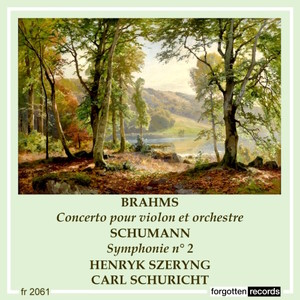
Johannes Brahms (1833-1897)
Violin concerto in D major, Op. 77 (1878)
Robert Schumann (1810-1856)
Symphony No. 2 in C major, Op. 61 (1847)
Henryk Szeryng (violin)
Orchestre National de la Radio-Télévision Française/Carl Schuricht
rec. live (radio broadcast), 21 September 1955, Salle du Pavillon, Montreux, Switzerland. ADD mono
Forgotten Records FR2061 [77]
Given that there are studio recordings of Szeryng playing Brahms’ violin concerto with Monteux, Dorati and Haitink, it is understandable if a live, mono broadcast by him should have been overlooked but there is the additional interest here of hearing a conductor who was generally under-recorded and a celebrated violinist when he was still relatively young, playing before any of those studio recordings – this was recorded the day before his 37th birthday.
I came to this recording with two – not exactly prejudices; let’s call them assumptions: that Szeryng was a very great but sometimes rather anonymous violinist*, and that Schuricht favoured swifter, no-nonsense tempi. Eager to test out those ideas, in my mind I compare Szeryng with favourite violinists such as Milstein, Oistrakh, Ferras and Mutter in the Brahms; likewise, I compare Schuricht’s recording here of Schumann’s Second Symphony with those I like by Bernstein, Janowski, Levine and Stokowski.
First, a word about the sound; it is no treat, being fairly raw and screechy and it would be disingenuous other than to say that it is unlikely to satisfy anyone other than the determined Szeryng fan who is tolerant of “historical” sound – but it is definitely listenable.
Second, tempi: Schuricht is hardly very different from any of the other conductors above; in the Brahms, only Ferras conducted by Blomstedt (see my review) takes a minute longer over the Adagio but otherwise there are no significant indications of haste – and indeed, Steinberg with Milstein is considerably swifter in all three movements. Bernstein is almost three minutes slower in the Adagio of the Schumann symphony but that is his idiosyncrasy compared with the other conductors and Schuricht is pretty much central in the pack – so that’s that presumption scotched.
Regarding Szeryng’s supposed blandness as an interpreter, I can only say that despite the harshness and congestion of the indifferent sound quality, we can hear the ineffable sweetness of Szeryng’s tonal production, the accuracy of his intonation and the effortlessness of his technique. There is also some lovely oboe playing in the introduction to the slow movement. The finale is scratchily recorded but Szeryng’s virtuosity is manifest. Prolonged and vigorous applause is included.
I love those grand, stately openings to Schumann’s First, Third and Second symphonies as per here and Schuricht gets the mood right – but the wavery tape calls out for some Pristine-style intervention. I really like the way he achieves a sense of momentum but acknowledges that when Schumann gave the indication “Allegro ma non troppo” he meant it, so the music always retains a sense of grandeur and dignity, so isn’t rushed. The scurrying, Mendelssohnian Scherzo is elegantly despatched but the orchestra seems remote in the sound picture. The Adagio rocks gently and the finale storms the barricades; we can assuredly hear that this is a lovely performance but can do so only through the veil of crumbly sound nearly seventy years old. I am an old hand at listening to vintage recordings – if you love great voices, you have to be – but in truth, given its sonic limitations, I wonder how many punters will want to purchase and listen to this when there are so many preferable options available – including better recorded studio performances of the violin concerto by the same violinist.
Ralph Moore
*My MWI colleague Jonathan Woolf, in his review of Szeryng’s later recording of the Brahms and Mendelssohn violin concertos with Haitink, quotes Itzhak Perlman’s joke that “[w]henever he listened to a performance on the radio…and couldn’t recognise the fiddle player, he knew it had to be Szeryng.”
| Availability |  |


















